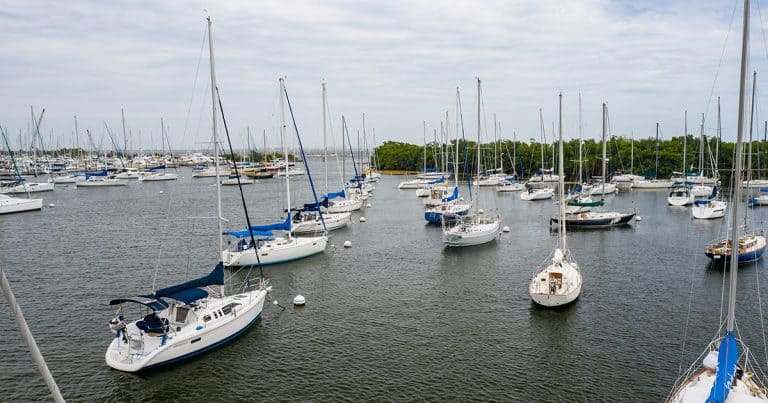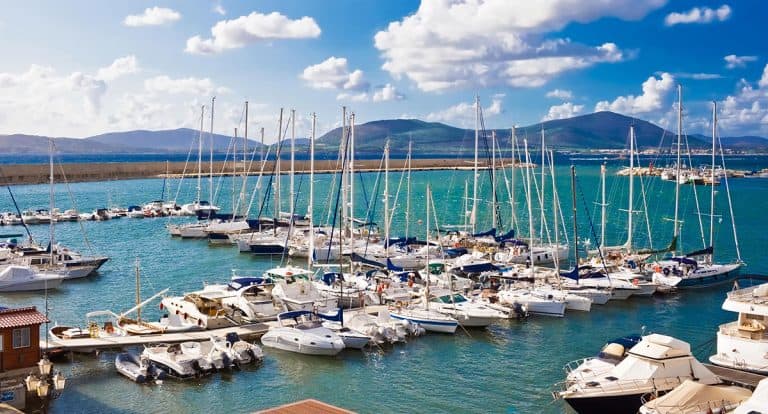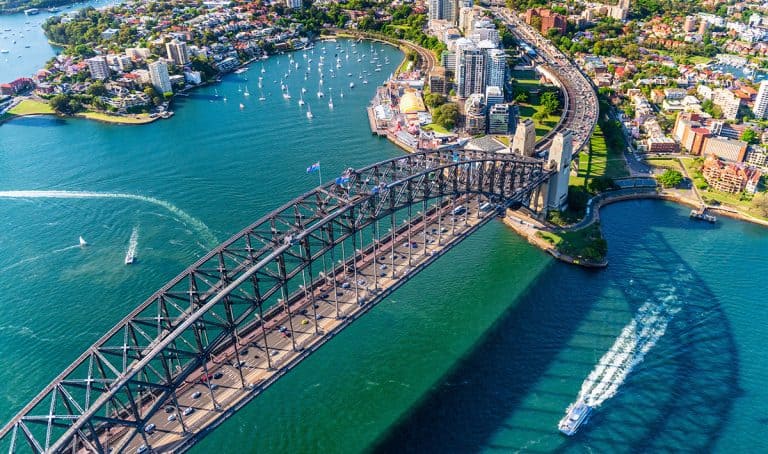Costs of Living on a Boat: 7 Couples Share Their Budgets
“What’s the cost of living on a boat?” This is a question that people ask themselves when they’re considering whether or not to live full-time on their boats.
As I was looking into our dream of sailing around the world, I spent a lot of time trying to figure out how much to budget in terms of monthly expenses. Luckily, there are many liveaboards on YouTube who are more than eager to share their budgets. Their individual cases may not represent your typical boat owner’s expenses, but when you put them all together, you get a pretty decent estimate.
So I watched a lot of videos and made a spreadsheet to calculate the averages of seven liveaboard couples who have lived full-time on their boat for at least a year. And here is what I came up with:
Based on seven liveaboard budgets, the average monthly cost of living on a boat is $3,433 with the lowest being $1,300 and the highest being $5,732. This includes all living costs, including food, insurances, utilities, and other expenses.
These numbers are based on couples living on a boat together. Thus the cost of some budget items would be slightly lower for one person living alone. But for most items, the cost would be about the same regardless of the number of people living on the boat.
Boat insurance
The average cost of boat insurance is $289 per month, with the lowest being $1500 a month and the highest being $500.
Insurance is a necessity when living on a boat. This covers your boat in case of storms, accidents, and other issues. But it also covers liability if you damage someone else’s boat.
Many countries require that you have boat insurance. If you are in a country that doesn’t require this, it is still an important thing to have. If something goes wrong and you don’t have insurance, you will be paying the full cost for any damage done, which could be very, very expensive.
The cost of insurance is based on the size and type of your vessel, where you are sailing, the length of time that you will be cruising annually, and other variables such as years of boating experience or any previous insurance claims.
Not only is insurance expensive, but it can be difficult to find a company that offers coverage for liveaboards. They are not as common, and there is a risk that your boat will be very expensive to insure.
Many liveaboards report that they are finding it harder and harder to find good and affordable coverage. Some people also report that they have been turned down by companies when their boat is too old, or because of the type of vessel (for example an aluminum-hulled sailboat). So be prepared to spend some time looking around for a good insurance company and asking lots of questions.
Repairs and Maintenance Costs
Our seven cruising couples report spending on average $1,157 per month on maintaining and upgrading their boat, with annual budgets ranging from $266 to $2,583.
Repairs and maintenance is by far the costliest item in our cruiser budgets, and it varies widely from year to year and depending on the boat’s age. Some years there will be very few repairs needed, while in other years you may need to replace key components or fix a lot of small things.
The cost of repairs and maintenance is higher for older boats, but it varies from boat to boat depending on materials, build quality, and how well the owner maintains them. Some cruisers report that they’ve spent more than $60,000 on repairs over just a few years but most reported costs ranged from about $20-$40K over a five-year period.
Expected annual maintenance costs are often cited as anywhere between 10% to 30% of the boat’s purchase price, though the percentage can vary substantially from boat to boat and year to year. We recommend cruising sailors budget between $800 and $1,000 per month for unexpected repair costs. That is a lot of money, but it is still less than the cost of renting or owning a typical house. The good news is that many items can be made yourself with enough time and patience.
When buying a boat, it’s important to have a professional survey done to make sure there are no hidden defects. Paying $500 to $1,000 for a throughout survey is money well spent. It would save you thousands of dollars in the future.
Bureaucracy and Red Tape
The average fees and charges for a liveaboard couple amount to $83 per month and varies from $51 to $131. This is lower than most other categories on the budget, but still a noticeable expense that many people may not be considering when budgeting for a life on the water.
Sailing from country to country involves a lot of paperwork and bureaucracy. For one, there is the boat’s registration to consider. Then there are the visas that each member must obtain from their respective countries in order to get on shore and a ton of other paperwork. With all these documents required for travel, it can be a daunting task if you’re not used to dealing with this type of red tape.
Depending on and your nationality and where you go, this will be more or less of a hassle. Fees and taxes will also vary from country to country. Some places charge very high fees for anyone to enter, while others are very lax and focus on customs instead.
Mooring and Marinas
According to our seven liveaboard budgets, the monthly costs of moring and other dockage is $309, ranging from $85 to $817.
Unsurprisingly, the cost of living aboard a boat varies from person to person and from location to location. One consideration is whether you want to live in a marina or anchor out. Marinas typically have better security, access to shore amenities like laundry and showers, but also cost more than anchoring outside of the harbor.
Whether you stay in the marina most of the time or you plan to anchor out, you will from time to time need to dock your boat for repairs, go ashore to visit a friend or take a trip into town. If you are anchoring, you will also need to find a place for your dinghy while you are on land, which occasionally involves paying for use of a dinghy dock. You will also need to pay for dry storage if you are not using your boat for a while or when it needs extensive repairs.
In some places, anchoring isn’t legal, safe, or practical so that means leasing a mooring ball, which is cheaper than marinas but not free. Marina costs include an annual, monthly, or daily rate as well as using their facilities like showers, washing machines, electricity, water hookups, etc.
The cost of mooring balls and marinas varies wildly depending on the location, whether or not it is seasonal (typically there will be cheaper rates in the off-season), and how long you stay at one spot.
Fuel Costs
Based on data from the seven liveaboards who shared their budgets, the average monthly cost of fuel is $112, ranging from just $30 to $217. The only couple living on a trawler had the highest monthly expenditure for this category at $217.
Some people prefer living on a trawler or other motorized boat. This is a great choice if you intend to mostly stay in the marina as they offer a lot of space. But if you plan on sailing a lot, this may not be the best option as they do use a lot of fuel. That is why most cruisers prefer sailboats as they use much less fuel.
But regardless of what type of boat you choose to live on, you will always use some fuel when maneuvering within the marina or when the wind speed is too low to sail. And of course, fuel for the outboard when you need to go ashore for provisions and other errands.
It is also necessary to consider the cost of heating your vessel in colder areas as these boats don’t typically have efficient insulation or heaters. You will typically need to rely on propane-fueled appliances instead of electric heaters to minimize the use of your limited battery capacity.
A lot of cruisers have solar panels and/or wind turbines which help them save money by providing their own electricity for electric utilities and other needs. This will also help to keep down the need for running the generator.
Groceries
The average cost of groceries for liveaboards is $634 per month, ranging from just $371 to $1,075.
In addition to all the boating-related expenses, you will have to factor in the cost of food, toiletries, and other non-food items. Unlike land-based living (where you can buy groceries at your local store), boaters must either provision well and keep a well-stocked pantry/freezer on board, or rely on regular trips to the mainland for provisions.
Most liveaboards report that their grocery costs remain about the same as when they were living on land. The cost of fresh produce is usually offset by the reduced price of canned and frozen foods. In some locations, food is very affordable, but in other areas, it can be quite expensive. You may save a bit of money by catching and cooking the occasional fish, but the cost of your fishing gear will need to be factored in.
A good starting point is your current grocery budget. Ultimately, however, it’s up to you. The cost of groceries while living on a boat is largely dependent on your decisions and preferences, as well as where you live or travel for supplies. If you plan carefully and keep a well-stocked pantry/freezer on board, you can keep your costs relatively low.
Water
Only one couple in the dataset reported buying water instead of using a watermaker. Their monthly costs were $36.
Boat life means being very conscious of how much water is used – quick showers, turning off taps as soon as possible, limiting the use of dishwashers and washing machines, etc.
Some marinas don’t charge for water, but many marinas do, so it is important to conserve as much as possible. Water can be quite a challenge if you try to stay out of the marinas, which is why most cruising liveaboards have a watermaker.
Watermakers are expensive to buy, require electricity to run, and it takes time before you recoup these costs. But when you consider the hassle and the expense of constantly having to look for places to refill the water tank, they are often a worthwhile investment.
Entertainment
The average monthly entertainment budget for liveaboards is $539, with some spending less than $300 and others over $800.
Entertainment is a very individual thing. Presumably, you enjoy sailing, swimming, and all the other forms of activities that the ocean has to offer. In which case you can always find free entertainment and you don’t have to spend much money. But most people will occasionally want to go out with friends for a meal or watch a movie, both of which cost money.
Many people who live on boats end up spending less than they did before when looking back over the year because they are living a life they love. Others will still go out and have fun to get away from what can be a rather isolated lifestyle, or perhaps because they enjoy experiencing the local cuisines.
The point is: we are all different and with different needs, so there isn’t really one answer other than to say that entertainment will cost as much or as little and you want it to. Just as is the case on land.
Transportation Costs
The average cost of transportation is $166 per month, with the lowest being $117 and the highest being $208.
To live aboard a boat does not mean you never need to use other means of transportation. Sometimes you will need a taxi or other form of land transport to buy groceries, for exploring, etc. Or for longer inland trips.
And then there are those rare occasions when liveaboards must fly back home because they have an emergency or an event they can’t miss. While it doesn’t happen that often, airplane tickets can be expensive.
As with many other budget categories, this is largely up to you and your personal preferences. But it’s important to consider those potential expenses and factor them into your liveaboard life.
Communications
The cost of internet and phone service varies significantly while living on a boat: the average monthly bill is $187, but it can be anywhere between $76 and $325.
Living aboard a boat often means living in isolation for months at a time, so communications can be one of the most important things for boat dwellers.
Some boaters use satellite phones to stay in touch with loved ones and others on land. Others just use local phone cards when needed to save money. It can be a bit of a hassle to navigate the jungle of data plans – especially when if you don’t speak the local language.
The good news is that the costs of phone calls and data have come down significantly in recent years, making it easier to stay connected without breaking the bank relying on very expensive satellite phones.
Miscellaneous Costs
The average liveaboard couple spends a total of $272 per month on miscellaneous expenses, but this figure varies wildly from just $11 to $815.
Finally, there are all the other costs that full-time liveaboards should budget for. Some of these are part of the daily (or monthly) routine, like laundry. Others are infrequent, such as the occasional trip to the veterinarian if you have pets onboard. A typical list of miscellaneous expenses includes:
- Pet food and supplies. Many liveaboards have a dog or cat to keep them company.
- Bank fees related to converting currencies, making transactions, or withdrawing money from ATMs.
- Postage and shipping when sending or receiving packages.
- Laundry if you don’t have a washer on board.
- Payments on boat loans
You might also want to factor in some money for an emergency fund, as well as a few hundred dollars per year set aside to cover unexpected costs, such as replacing a stolen outboard, which is sadly more common than one might think.
Healthcare
The average liveaboard couple spends $121 per month on healthcare, with costs ranging from $100 to $158.
Healthcare insurance is essential when living and traveling on a boat. Most of the couples have some form of medical insurance, either through an employer or private health coverage.
Some countries require proof of health insurance before entry; some do not. If you do not have insurance, it is worth checking with your country of destination or any transit countries beforehand in order to avoid surprises later on and hefty fines from border control staff members.
Considering the costs of healthcare in the United States, many insurance companies offer affordable plans that cover emergency health care outside of the U.S. It’s worth noting that you can still get medical care in the US, it just might not be as affordable. Your best bet is to do your research and find out which providers are covered by insurance for which kinds of emergencies and what your deductibles are.
How to Keep The Costs of Living on a Boat Down
While living on a boat can be cheaper than other living situations, it does come with a few expenses. Here are some ideas to help you cut down on your costs while still enjoying the benefits of boating life:
Eating Out Less Often
If there is one thing that can make or break most people’s budget, it’s going out for dinner at restaurants and bars. Plan ahead by packing snacks and prepare meals in advance so you have leftovers. This way, when hunger hits during an outing, you won’t need to purchase pricey takeout food – instead, opt for something homemade.
Be Self-sufficient
Try to be as self-sufficient as possible. This will save you money in the long run and allow you to spend your time doing what matters most to you instead of always running errands. Self-sufficiency includes things such as:
- Installing a watermaker
- Generating your own electricity by installing solar panels and/or wind turbines
- Spending most nights anchored instead of relying on marinas
- Catching your own food
DIY
DIY maintenance is perhaps the most important part of how you can reduce your costs to live on a boat. The more time and effort you spend learning about the engine, plumbing, electrical systems – or any other aspect of boating for that matter – the less money you’ll need to pay someone else to troubleshoot and repair them.
Also, buy a simple boat that requires limited maintenance, and don’t go “overboard” on upgrades. A smaller boat will also keep your mooring fees down.
Say No to Bureaucracy
Travel to countries with low or no fees on visas, permits, and other bureaucratic mess. It may well be worth your time planning your trips accordingly.
Stock Up on Food
The cost of food varies a lot from location to location. You can save a lot of money by stocking up on non-perishables in countries with cheaper food, and then consuming it in countries where you would be spending more money on groceries. Of course, you probably don’t want to live off of rice and canned food all the time, but you’ll spend less on food if plan your shopping trips ahead.
Shop Around for Marinas
Look for affordable marinas when you have to dock your boat for a few days, or weeks. Some locations are more expensive than others even in the same approximate area, so make sure to check prices before you dock. Be sure to shop around whenever time and circumstances allow.
Stay Out of High-Risk Areas
Avoid staying in hurricane-prone areas during hurricane seasons. Such as the Caribbean. Boat insurance skyrocket for boaters traveling in these regions.
Do Your Own Laundry
It may be worth it to do your own laundry. Laundromats can be very expensive, especially in marinas. If you have the room, electricity, and a watermaker, you could install a washer & dryer, but you can also do your laundry in plastic tubs.
In Summary: Be Realistic About Your Budget
When you live on a boat, your monthly expenses will be different from someone who lives in an apartment or house. For example, maintenance costs are typically higher and the cost of living is more variable because what you need to spend varies so much based on where you dock for the night.
In general, though, it’s safe to say that most people can expect their average monthly expenditures to fall between $3,000 and $4,000 per month; with some months costing less than $1,000 while others may exceed $15,000.
The important thing is not how expensive one month might have been but whether it was sustainable over time which means considering your long-term budget.
When you plan to live on a boat, be sure that you are realistic about the cost of living. If the above averages sound out of reach for where you’re at in life right now, remember there are always to keep your costs of living down. As long as you are willing to be creative and make sacrifices, there are ways you can live on a boat cheaper than the average.
Note: The data presented in this article is based on budgets from the following YouTube boat lifers:





